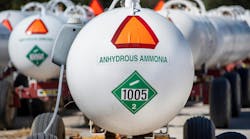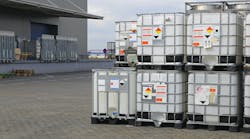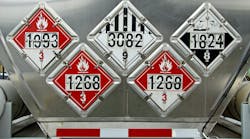THE Environmental Protection Agency's (EPA) newest initiative — “Uniform Standards” proposed in Part 65 — represent “the most monumental shift of paradigm in the history of air regulations,” according to Rob Ferry, a partner at the TGB partnership in Hillsborough, North Carolina.
“It's happening under the radar of most folks, in that there is no immediate applicability,” Ferry said. “However, when sector-based rulemaking imposes the ‘Uniform Standards’ on you, the rules themselves will already be final. Your opportunity to comment is now.”
Ferry said there would be new rules for each type of emissions source under “Uniform Standards” proposed in Part 65. They would be similar to the “Standard (Generic) Standards” that included Part 63 Subpart WW and would only be applicable if invoked by another rule.
The “Uniform Standards” will be rolled out in two phases. Ferry described what was coming from the EPA in a presentation made during the 2012 International Operating Conference that was organized by the International Liquid Terminals Association and was held May 21-23 in Houston, Texas.
“Initially, they developed the ‘Uniform Standard’ rules,” he said. “The first industry group to be covered was heat exchangers, or cooling towers, last fall. The next group was proposed March 26, 2012, and includes storage tanks and loading racks under one rule. Theother two are for equipment leaks and control devices. In order to make them applicable, the EPA intends to revise existing rules to invoke the ‘Uniform Standards’ (sector-based rulemaking). They will go through the industry sector by sector and revise all rules that potentially apply to that sector to have those rules point to these new uniform standards.
“The EPA is beginning with rules applicable to the refining and chemical industries. For example, for the petroleum refining industry, they could come out with new rule that says if you have new sources in the petroleum refining sector, instead of complying with previous requirements, you will now comply with the ‘Uniform Standard.’ There will then be a single set of requirements for all tanks at a refinery — it will be a ‘Uniform Standard.’”
The proposed rules are pending and will be final by the end of the year.
“The intent is to streamline the current regulatory structure into a single set of requirements in each industry sector,” he said. “There is a short-term burden to deal with a completely new set of rules, replacing all existing requirements. The present regulatory scenario seems incredibly complicated, and we have this byzantine labyrinth, and confusing and overlapping regulations. It gets horribly confusing to keep up with all of that. However, the industry has had to do it for so long that most folks have a compliance program in place to address this overlap.
“There is a long-term benefit due to simplification — if the new rules are clearly written with reasonable requirements. If these new rules straighten out some of ambiguities and interpretation issues that plague the old rules and clearly state what the EPA's intent is, it will make life simpler. But looking at the draft ‘Uniform Standards,’ I don't think anyone will conclude that this is presently the case. In reality, there are significant new burdens.”
As proposed in Part 65, Subpart I, storage vessels and transfer operations are combined into one “Uniform Standard.” He said the starting point for floating-roof tanks is Subpart WW, including deck-fitting controls. New (additional) requirements involve: requirements for fixed-roof tanks and floating-roof landings. Not addressed: tank degassing/cleaning operations.
“The rule would require controls potentially applicable to loading of diesel and other low-volatility stocks,” Ferry said. “Presently, if you load liquids below a certain vapor factor, they are not subject to control. It needs clarification that controls apply only to loading — not to unloading. Control-device requirements are based on refinery/chemical requirements, not gasoline-loading requirements (ie, not the Gasoline Distribution Area Source Rule, GD GACT).
“Perhaps the biggest concern in all the ‘Uniform Standards’ is that they use this term ‘regulated material,’ and they'll say if an emission point contains or contacts regulated material, then it's subject to the standard. The ‘Uniform Standards’ define regulated material as ‘chemicals or groups of chemicals, such as volatile organic compounds or HAP, that are regulated by the referencing subpart.’ This is potentially subjecting virtually all previously exempt emission points to new requirements. For tanks, vapor pressure and capacity thresholds determine whether a floating roof is required, but tanks below these thresholds are subject to the new requirements for fixed-roof tanks.”
He said all fixed-roof tanks will potentially be subject to requirements, regardless of vapor pressure. Open vents are not allowed (each opening in the fixed roof to be equipped with a closure device). There will be regular monitoring of the fixed roof for leaks and of the true vapor pressure of the stored liquid.
Other key points:
- Open vents are not allowed, §65.310(a) & (b).
“Open vents (e.g., gooseneck vents) on fixed-roof tanks would have to be replaced with self-closing P/V vents. P/V vents would be allowed to open for relief of pressure due to ‘diurnal ambient temperature fluctuations’ (i.e., breathing). So they acknowledge that these vents are going to open every afternoon for breathing, yet they require that you do testing. There seems to be a logical disconnect. As a practical matter, low-volatility stocks you tend to store in larger fixed roof tanks are so low in volatility that even with venting they probably won't register a leak.”
- Monitoring of fixed-roof tanks, §65.310(c) & (d).
“Monitor by one of the following methods: Method 21, annually, 500 ppm leak definition; or optical gas imaging (IR camera), semiannually, any visible plume is a leak. This requires notifications and records for each inspection, and repairs within 45 days, with up to two extensions of 30 days each. “
- OGI Monitoring, §65.310(c)(1)(ii).
“Optical gas imaging (OGI) with the IR camera to be done per the protocol specified in 40 CFR Part 60, Appendix K. But Appendix K has not been proposed yet. How do we comment on that when we can't see the procedure? I get the sense there is a fair bit of frustration on the industry's part in responding to these standards.”
- Monitoring Stock Vapor Pressure, §65.306.
“If a tank stores a mixture for which the true vapor pressure was determined to not require a floating roof, the maximum true vapor pressure (MTVP) must be determined annually, and must be done by testing. The use of reference tests won't be allowed.”
- Floating Roof Landings, §65.315(b)(1) & (2).
“Limitations are proposed concerning: the scenarios in which a floating roof may be landed without controls; the duration of the landing, and the conditions under which refilling of the tank may be interrupted. Low-level monitoring is required — as is high-level monitoring, for potential overfills.”
“The floating roof may be landed for: initial fill; emptying the tank for maintenance or inspection; changing the service to an incompatible liquid; or taking the tank out of service. If landed for any other reason, vapors must be routed to a control device.
“For acceptable floating-roof landing scenarios, actions to either refill or completely empty must begin within 24 hours. If the landing will be longer than 24 hours, vapor controls are required upon landing. Once refilling has begun, you may not withdraw liquid from the tank until the floating roof has been refloated. Suspension/interruption of refilling is allowed only in the event of batch operations, where a batch receipt has insufficient volume to refloat the floating roof.”
- Loading operations: applicability, §65.360.
“Controls apply if facility-wide transfers exceed 35 million gallons per year of high-volatility liquids (greater than 4 psia). Once a facility is affected, all loading racks are potentially subject to control requirements, regardless of vapor pressure. Applicability to low-volatility liquids could be waived in the referencing subpart.
“Control-device requirements are based on refinery/chemical plant requirements. It does not include the GD GACT provisions for gasoline loading. It would be dependent on the referencing subpart to specify alternatives, such as those in GD GACT.”
- Container Requirements, §65.370.
“All containers must be kept closed except when accessing, and use either submerged fill or a ‘fitted opening in the top of the container.’ There is no minimum size — it could apply to sample bottles. If larger than 55 gallons and MTVP is greater than 4 psia, perform annual leak-tightness testing.”
He said that in the floating-roof revisions as compared to subpart WW: all STERPP options are expressly allowed for slotted guidepoles, including the “flexible enclosure”; ladder sleeves are expressly allowed for ladder/guide pole combinations; annual inspections are once per calendar year, rather than due by the anniversary date.
Ferry said he could not estimate the cost of compliance for a terminal with diesel storage tanks.
“The scope would be if you presently have open vents and have to replace with P/V vents,” he said. “You also have to do an annual sampling of liquid in each tank, and annual leak testing of the fixed roof, and have records and reports. If you just have a few tanks, it may not be big a deal. But if you have lots of tanks, it's a big burden with no environmental benefit. It seems to be going in exactly the opposite direction from what the federal government has been telling us since the 1990s: reinvention of government, cheaper, faster, smarter.” ♦










